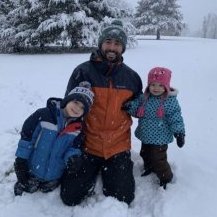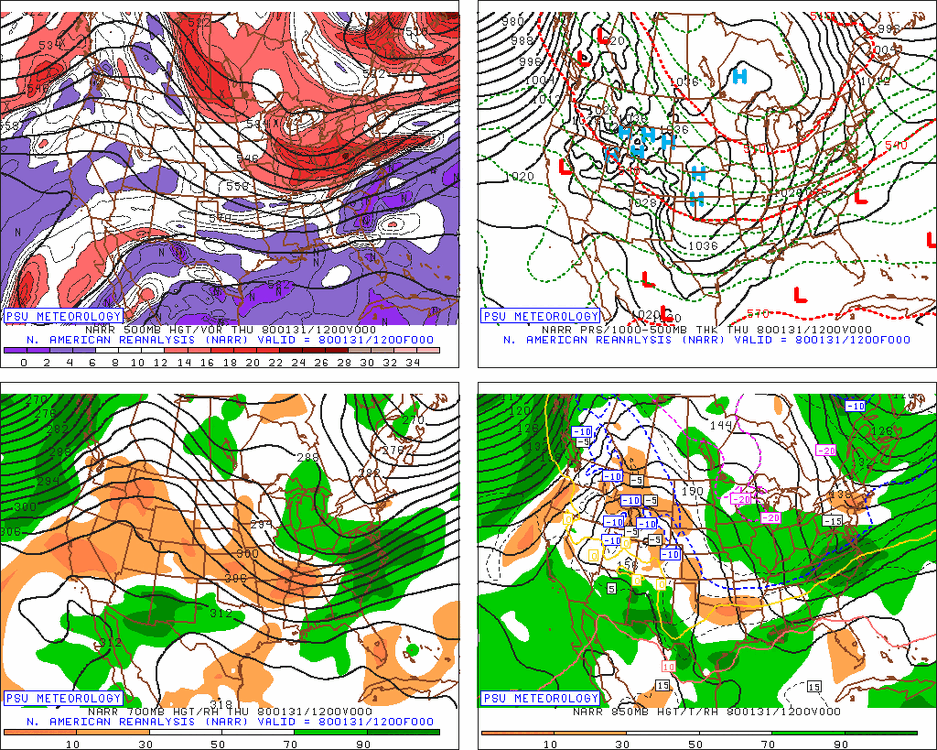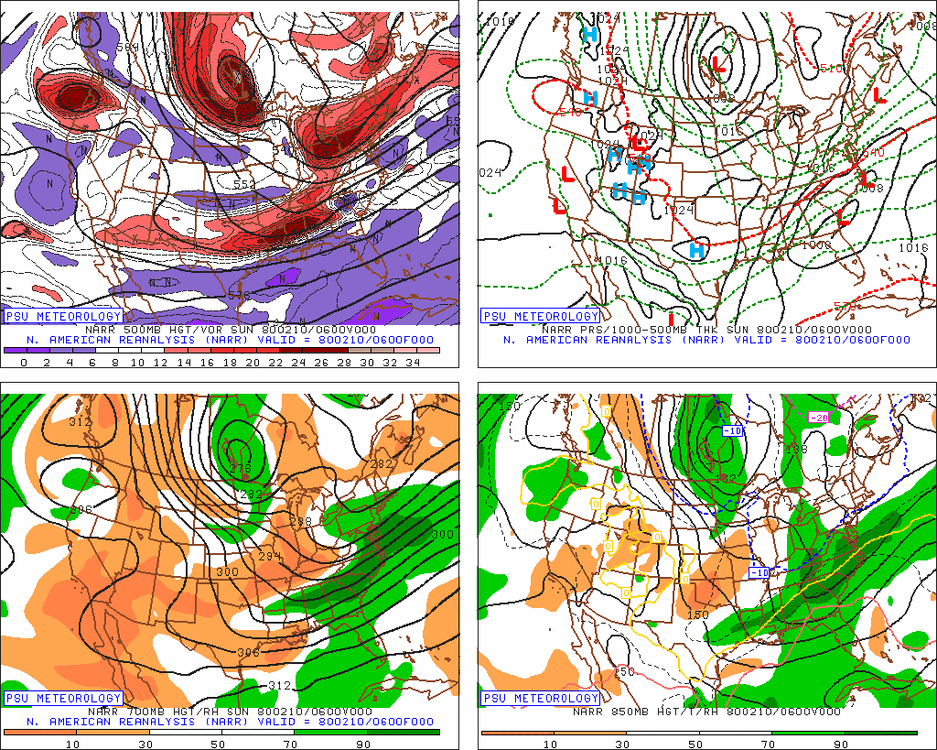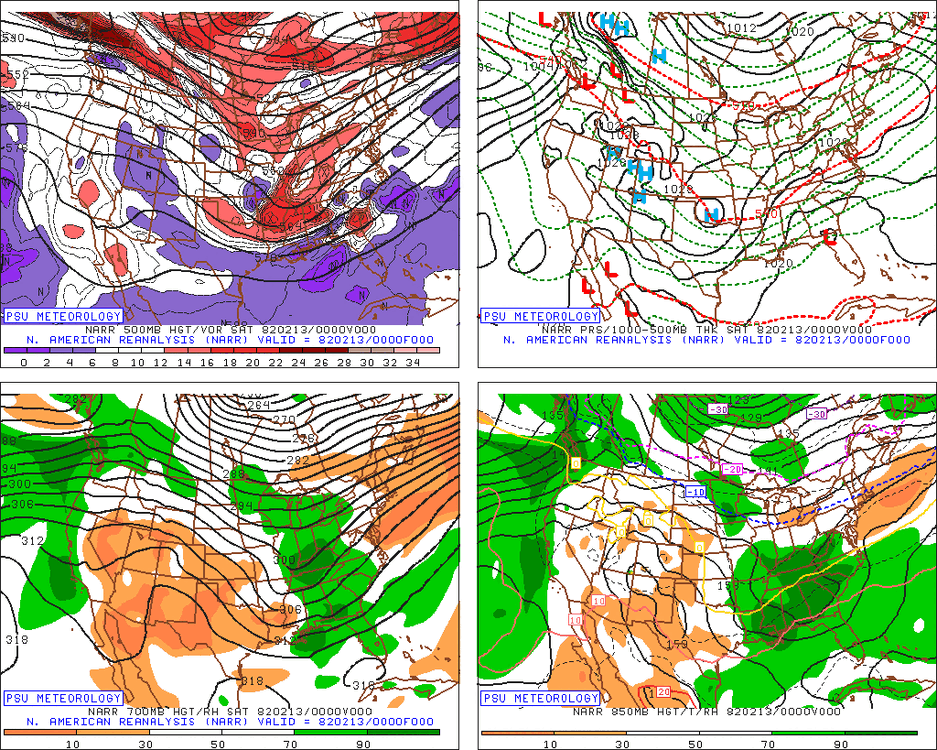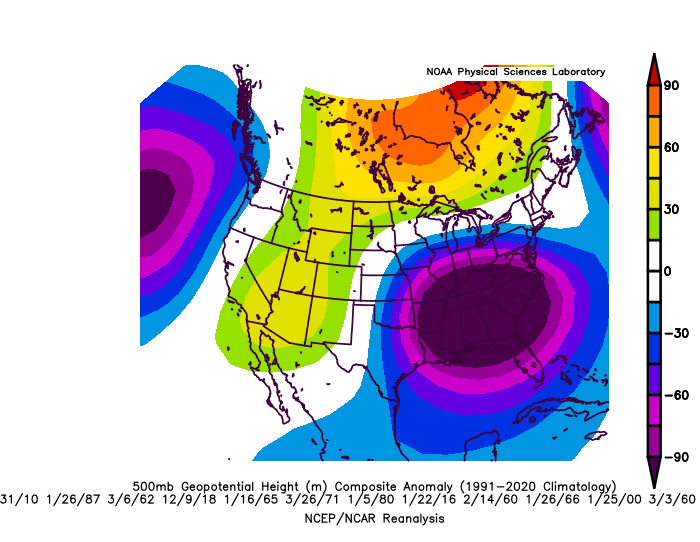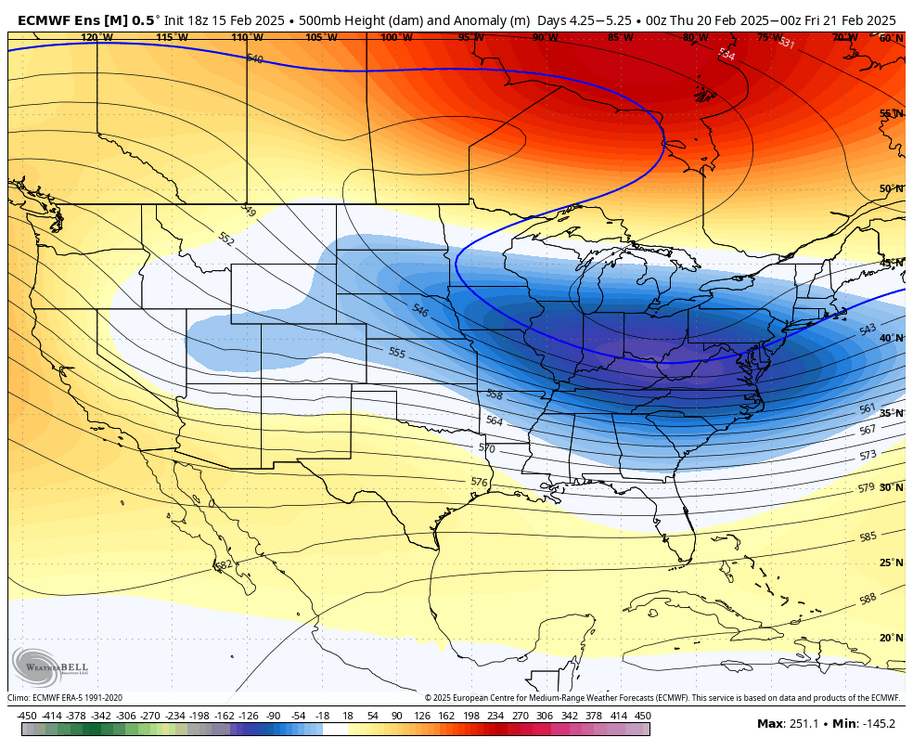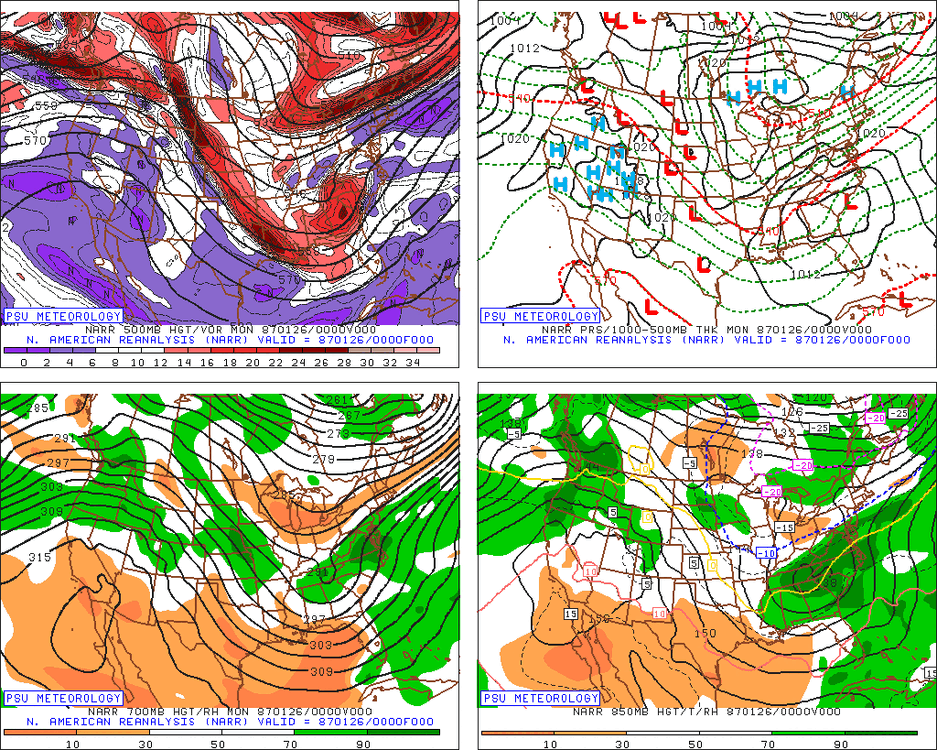-
Posts
26,725 -
Joined
-
Last visited
Content Type
Profiles
Blogs
Forums
American Weather
Media Demo
Store
Gallery
Everything posted by psuhoffman
-
I’m gonna die on this hill, I went through every single analog on that list, most of them I’d already identified yesterday and looked at, and not a single is even close to the h5 look we have this week. They must be using the surface heavily to identify these. Again I’ll use the GFS, euro is even more amplified. now here are some new analogs on that list that were big snows to our southeast, but look at the h5 track, way south of this week and a way more suppressive look up top. The differences at h7 are even worse. I’ve never seen a snow for southeast Va with a h7 low over PA. Which brings me to the best example at the mid and upper levels to this week on that analog list it’s not a good match but I said “best” match. The h5 track is at least similar but way way less amplifies. The result was a weak wave south that didn’t really give anyone much snow. Thats a believable outcome. But I still cannot find a single example of a h5 and h7 setup even close to this week they resulted in a southeast VA or Delmarva snowstorm. I ran the composite for all 8” snows for Richmond and Salisbury and the h5 min anomaly was centered on Atlanta. This week it’s centered around KY. That doesn’t even match the DC snow comp best, it’s the closest to the NYC storm comp. Something has to give here. Unless we really are going to see something that’s never happened before I see 3 possibilities. From least to most likely. 1) the guidance is going to adjust at h5/h7 way way south with those features (from a OH to PA pass to a KY to southern VA pass) and then a big snow centered down there makes sense. This is really unlikely given the degree of chance that requires. 2) Guidance is going to trend significantly de-amplified at H5 and there will be a more modest snowstorm to the southeast. This is slightly more possible. If the h5 ends up stretched out and not closed off up top a weaker but not totally insignificant wave can slide east under it and drop a 6-12” type snow to our south. That’s still a significant h5 change for this range but it as crazy as what’s needed to match the 10”+ southeast snow analogs 3) the surface adjusts. This is by far the most likely imo. The issue here is the surface could adjust in two ways. One it could adjust to a snow further north, like some of the ones on that analog list that actually do fit the h5 better. But I’m wondering given the seasonal trends and Nina of the most likely adjustment is for the surface to de-amplify into a weaker wave that becomes a minor (say 3-6”) type snow somewhere close to where the max is now. There are examples of very weak waves failing to get “captured” by a similar h5 or simply being too weak to gain latitude in this type flow and then hitting places like SE VA. So if this were to adjust weaker then the surface track makes sense What I can’t see is the mid and upper level pattern projected right now across guidance producing a 12”+ snow for SE VA or the Delmarva. Just like we look at the pattern comps for us to identify when that kind of storm is coming, this doesn’t fit the pattern comps for a big snow there. It’s not even close.
-
99% of the time the most extreme model in either direction won’t 100% “win” it will end up a compromise. Even the event today I used as an example of a euro v all win, the euro was “slightly” over amped and while it was a huge win it did come maybe 10% while all others came 90%. So when the most east models come west a little bit it doesn’t mean it’s a west trend across all guidance or that the more west models will also go west. It’s more likely just convergence happening.
-
I agree with your point about a flatter wave possibly, but my main point is I looked through trying to find any examples of a significant snow to miss us to the southeast like that from a closed H5 low tracking through OH and southern PA like all guidance has...and couldn't. Every snow to miss us southeast like that had a much further south H5 track and a more suppressive flow over the top. So...either this trends way weaker and misses south, or it probably has to come north if its anywhere close to as amplified a wave as guidance has now, because the upper flow is not right for a big southern VA snowstorm. Its either a weak washed out wave that slides south, or if its amplified enough to be a big snow it will end up further north.
-
wrt euro v all others...actually it ended up being 2mb and maybe 20 miles off on is SLP placement from 120 v what it shows now at 24 hours and has the precip almost exactly where it is. It pretty much nailed the storm from 120 while literally everything else, including the AI, was over 100 miles off.
-
@Terpeast Euro might have been slightly over amped in the end though, which is not good considering we need it to win 100%, but from 120 it was way way closer than everything else Euro at 120 All others Current Forecast
-
It kinda did up in New England this week. I was watching because there was a chance I was going up there to ski this weekend with the kids. Earlier this week there was a point when the IKON, AI, GGEM and GFS were all showing snow with a track closer to the coast. The Euro was more amped and NW with freezing rain and sleet getting all the way into northern VT. Eventually all the other guidance came around. Oddly after it did they then had a couple runs where they would go back to a SE solution before coming back NW again. Looks like the Euro had the right idea. But this is just one example...and a different setup. Usually when the euro is totally on its own its wrong, but over the years its more right in that setup than any of the others.
-
ok but no one has been able to answer me this...models are showing a big snow to our SE, why can't I find a single example of a big snow for SE VA with a H5 low crossing OH and PA? Every miss to our south like that has an H5 crossing VA or NC not to our north. What am I missing?
-
Ugh now guidance is trending towards a believable south fail. A weak wave that’s not a big snow for anyone. I just didn’t think that’s where it was heading. Even the misses were clobbering SE of us. But if it ends up a weaker system with no significant 8”+ snow anywhere that actually makes more sense.
-
Looping to 81 hrs it has the look of incoming not gonna miss. Tn valley wave is healthy and all. I don’t buy they it just dies coming east with a non suppressive flow.
-
Most…it was ALL
-
True but if it goes down that way imma need an explanation why for 3 straight runs every op was NW of their ensembles. Significantly so. It was too many runs consistently for it to have been a random fluke of the ops spitting out an outlier.
-
just shoot me
-
This is the composite 1 day mean h5 anomaly of all Richmond 8" snowstorms since 1950. Note where the mean anomaly is centered. This is the EPS 1 day anomaly for our storm
-
yea lol
-
Thanks! There goes what was left of my productivity
-
We want a miller b hybrid actually...without the wave into the TN valley the coastal initiates too far southeast...its rare for us to get a big snowstorm from that trajectory. Would take a really crazy capture phase. If the initial wave along the arctic front has a little more amplitude it causes a further north transfer and tucked location of the coastal off the mid atlantic and we need a less extreme interplay with the NS and STJ to get this to work.
-
yes, the H5 argues for this. There should be more amplitude to the wave along the arctic boundary with a transfer to the coastal off the mid atlantic coast.
-
yea we were discussing that fact (the analogs) earlier. Also that 87 storm was brought up by me as an example of a snowfall distribution similar to what guidance indicates now...but it had a significantly further south H5 track and a more suppressive flow over the top. I've yet to find a big Richmond-Delmarva snowstorm with an H5 low tracking through Ohio and southern PA. Maybe we are about to witness a first!
-
Ok just something that stuck with me...the 84 hours NAM was the first indication we had that the March 2017 storm I've said has some h5 similarities was going way NW of what guidance had indicated. We tossed it of course...NAM and all...no way was our snowstorm turning into a sleet bomb...lol We have much deeper cold air this time...we want that same shift in the track this time.
-
It's the NAM so... it's the NAM but it was about to open a can on us
-
-
The H5 track was closer to that storm but still further SE than this, otherwise not a lot of similarities. Also while that hit Richmond good it also got significant 12" plus snows way up into central PA and so didn't fit the criteria of what I was looking for. In terms of the "suppression" its more similar to this, which is kind of my point. This has nothing to do with warming IMO, sometimes weird bleep just happens I got into it with him a couple years ago, now I just ignore him
-
Would love your thoughts on this... why the disconnect between the H5 track here and the models depiction of the heavy snow?
-
Thank you, that was a great explanation. Honest question: Why can't I find any examples with this H5 look and a big snowstorm for Richmond to Delmarva where all the guidance says it will be right now? They all feature a significantly further southeast H5 track.
-
That was one of the storms I included in my set earlier of close misses to our SE. But again...look at the H5 and the H7 along with the RH for that storm... Now compare it to the GFS for this storm. Look how much less suppressive the flow is for this storm in every way!


